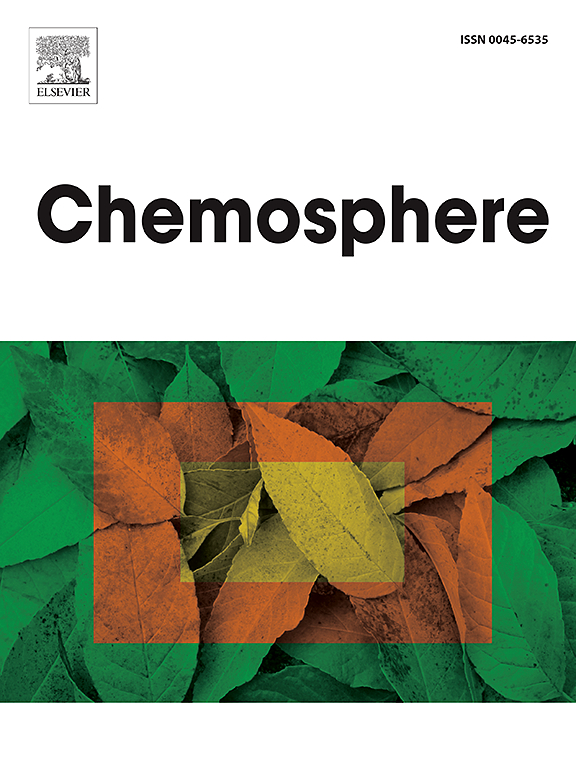阐明亚慢性暴露于二氧化钛纳米颗粒在波斯龙头特有物种的植物毒性终点。
IF 8.1
2区 环境科学与生态学
Q1 ENVIRONMENTAL SCIENCES
引用次数: 0
摘要
本研究旨在研究不同浓度(0、50、100、1000和2500 ppm)的二氧化钛纳米颗粒(TiO2NPs)对水培条件下波斯龙头植物的生理、生化和抗氧化防御反应的双重影响。在处理21 d时,暴露于50 ppm TiO2NPs的鲜梢生物量增加了26.2%,株高增加了18.2%。暴露于100ppm NPs对类胡萝卜素、叶绿素色素(a、b和总)和蛋白质含量的生物合成产生负面影响。场发射扫描电镜(FE-SEM)和透射电镜(TEM)分析显示,TiO2NPs沉积在根组织的细胞间隙和细胞壁内。与对照相比,脯氨酸和糖含量显著增加证明了2500 ppm NPs对生理胁迫的响应。植物根系过氧化氢酶(CAT)、抗坏血酸过氧化物酶(APX)和过氧化物酶(POD)的活性在100ppm至2500ppm NPs暴露范围内显著升高。与对照相比,2500 ppm时总黄酮含量增加了30.43%,100 ppm时皂苷含量增加了253.7%,环烯醚酮含量增加了22.3%,进一步证实了抗氧化能力。结果表明,TiO2NPs在亚致死剂量下促进植物生长,在高浓度下诱导不利的生化变化,激活内在防御机制,增强植物对NPs胁迫的抵御能力。最佳的纳米增产效果在50 ppm的tio2纳米颗粒中观察到,这表明了高产目标,这表明了农业生产力的潜在好处。本文章由计算机程序翻译,如有差异,请以英文原文为准。

Elucidating the phytotoxic endpoints of sub-chronic exposure to titanium dioxide nanoparticles in Endemic Persian Dracocephalum species
This study was designed to investigate the dichotomous effects of titanium dioxide nanoparticles (TiO2NPs) at varying concentrations (0, 50, 100, 1000, and 2500 ppm) on the physiological, biochemical, and antioxidative defense responses of Persian dragonhead plants cultivated in hydroponic conditions. Over 21 days of treatment, an increase in fresh shoot biomass by 26.2% and plant height by 18.2% was observed at exposure to 50 ppm TiO2NPs. Exposure to 100 ppm NPs negatively affected the biosynthesis of carotenoids, chlorophyll pigments (a, b, and total), and protein content. Field Emission Scanning Electron Microscopy (FE-SEM) and Transmission Electron Microscopy (TEM) analysis revealed TiO2NPs deposition within intercellular spaces and cell walls of root tissues. The physiological stress was prominent in response to 2500 ppm NPs as evidenced by a significant increase in proline and sugar content compared to the control. The enzymatic antioxidative defense was significantly upregulated by the enhanced activity of catalase (CAT) across exposure ranges 100–2500 ppm NPs, ascorbate peroxidase (APX) at 100 and 2500 ppm NPs, and peroxidase (POD) at 100 ppm NPs in plant roots. The antioxidant proficiency was further corroborated by increases in total flavonoids by 30.43% at 2500 ppm, saponins by 253.7%, and iridoids by 22.3% at 100 ppm NPs, relative to control. The results suggest that TiO2NPs fostered growth promotion at sub-lethal doses, and induced adverse biochemical changes at elevated concentrations, prompting the activation of intrinsic defense mechanisms to enhance plant resilience against NPs stresses. The optimal nano-stimulation performance was observed at 50 ppm TiO2NPs, which was suggested for the high yield targets, signifying a potential boon for agricultural productivity.
求助全文
通过发布文献求助,成功后即可免费获取论文全文。
去求助
来源期刊

Chemosphere
环境科学-环境科学
CiteScore
15.80
自引率
8.00%
发文量
4975
审稿时长
3.4 months
期刊介绍:
Chemosphere, being an international multidisciplinary journal, is dedicated to publishing original communications and review articles on chemicals in the environment. The scope covers a wide range of topics, including the identification, quantification, behavior, fate, toxicology, treatment, and remediation of chemicals in the bio-, hydro-, litho-, and atmosphere, ensuring the broad dissemination of research in this field.
 求助内容:
求助内容: 应助结果提醒方式:
应助结果提醒方式:


